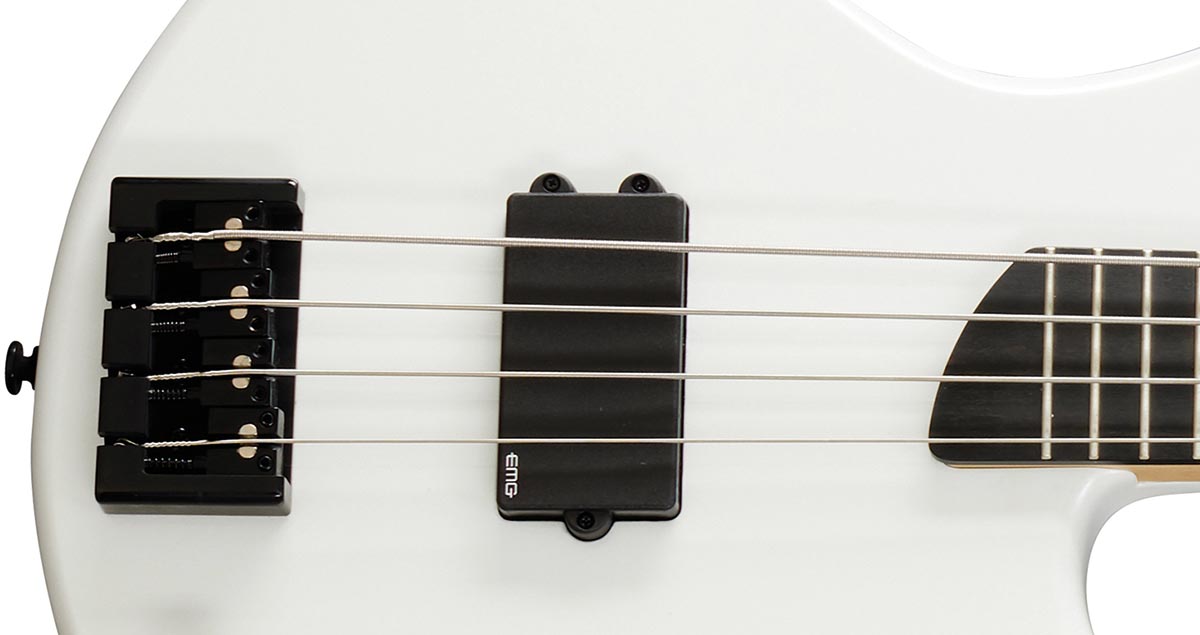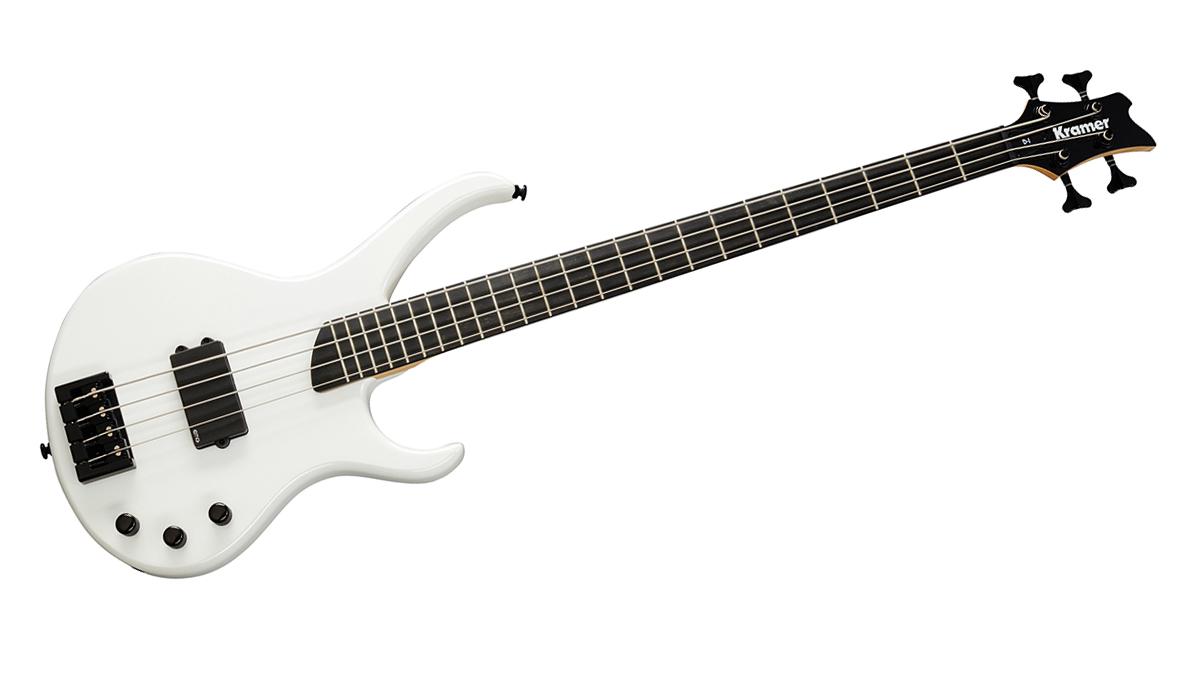Guitar World Verdict
The D-1’s understated aerodynamics and powerful bark punch well above its price tag.
Pros
- +
Plays like a dream.
- +
Feels compact.
- +
Solid build.
Cons
- -
Not overly versatile tone-wise.
- -
Tuning heads are a bit clunky.
You can trust Guitar World
Kramer have been giving us high-quality guitars since the '70s, and have seemingly gone from strength to strength since being acquired by Gibson in the late-'90s.
The D-1 is part of their new Kramer Modern Collection, the ‘D’ standing for Disciple, and the design riffing on their most popular bass guitars of the '80s – always a hit with heavy metal players. But is this latest Disciple something we can all believe in?
Build Quality
First impressions are always important, and the Kramer D-1 ticks all the right boxes on first glance, with its clean, fresh lines and sleek, elongated upper horn oozing minimalist modernity. A satin pearl-white finish shimmers enticingly in the light, and there’s nothing that indicates the lowish price tag which this bass carries.
Everything is finished off more than adequately, and the silky, slim C-profi le neck, its maple feeling sumptuously poised under a matte finish, is clamped tight to the body courtesy of a sturdy five-point bolt-on connection. An adjustable truss rod is hidden behind the triangular D-1 badge on the headstock. And that solid, compact body – weighing in at a modest 8.8 lbs, so definitely no back-breaker – literally thrums with vibration when strummed straight out of the box.

It really feels like an instrument with which you could defend yourself efficiently, which is always a bonus on the kind of live circuits I tend to frequent, and its economical design would certainly allow for plenty of swing in confined spaces. You might want to rethink the white finish if that’s on your agenda, but that aside, this isn’t a bass you’re going to have to treat with kid gloves. For the modest outlay required, it genuinely appears likely to last.
The neck is quite the dream for a budget bass, smooth and slick under the fingertips, not a sharp fret edge in sight, and surprisingly easy to navigate
The only slight eyebrow-raiser are the die-cast tuners, in the tried and tested two-up/two-down formation. These appear perfectly workmanlike, and are more than stable once in tune, but lack some subtlety when drop-tuning. Precise tuning is achievable, but it took a few seconds. However, the flush-mount bridge feels as if you could drop it from a plane and it would hold its intonation.
The EQ battery sits behind a plate secured by four fiddly little screws. In this day and age, every active bass should have an easy-access battery compartment, but hey, you can’t have everything, especially at this price.
Sounds and Playability
The responsiveness of the body timber makes this bass a pleasure to tinker with acoustically. It balances perfectly, admittedly with some slight neck-dive when on the knee, but that naturally corrects itself when on a strap, so gets the all-important ergonomic thumbs-up. It’s gently chamfered for comfort, with none of its edges grating anywhere, not even on this old bag of bones.
The neck is quite the dream for a budget bass, smooth and slick under the fingertips, not a sharp fret edge in sight, and surprisingly easy to navigate; I kept lying the bass down next to another instrument to check it actually was a long-scale, such was the comfort and speed with which I could traverse the glassy ebony fretboard.
This is deceptive, feeling shorter due to the compact body and the roomy cutaway of the lower horn, which allows total access to all areas. Its low action and 19mm string spacing is perfectly geared towards shredders with a need for speed.
The lightning action and percussive response definitely lends itself to the slap style, striking a fine blend of attack and clarity with the mid and higher ranges
Plugged in, the D-1 reveals itself to be just as pleasing. Wisely avoiding over-complicating sound options, you just get a volume and two tone controls, so you can quickly and intuitively dial in something workable and get on with playing the damn thing.
A slab of EMG goodness, in the shape of a middle-positioned EMG MMCS humbucker, energizes every note played. There is a pleasingly fat lower end, and plenty of oily grit for the rock and metal players who are most likely to vibe with the D-1 aesthetic.
The lightning action and percussive response definitely lends itself to the slap style, striking a fine blend of attack and clarity with the mid and higher ranges. Overall, this feels like a reliable instrument that will be able to make a decent fist of most styles.
Conclusion
There may not be a huge amount of variation in the tones you can generate from the D-1’s relatively simple EQ options, but the basic tone is great, and its outstanding playability and finish are exceptional for such a modest pricetag.
If you’re picking up a first bass, you won’t go far wrong with this, and more seasoned players who buy it as a backup will be promoting it to their go-to bass as soon as they’ve spent some time with it.
Specs
- PRICE: $529 / £399
- MADE IN: Indonesia
- BODY: Mahogany
- NECK: Neck Maple, 34”
- NECK JOIN: Bolt-on, five bolts
- FRETBOARD: Ebony, 24 frets
- PICKUPS: EMG MMCS humbucker
- ELECTRONICS: Active BTS preamp
- CONTROLS: Volume, treble, bass
- HARDWARE: Nickel
- WEIGHT: 8.8 lbs
- LEFT-HANDED AVAILABLE?: No
- CASE GIG/BAG: No
- CONTACT: Kramer
“Affordable versions of the three best basses I've ever held in my hands”: Sterling by Music Man completes its trilogy of Joe Dart signature models with a trio of made-to-order basses that cost less than $500
“The ace up the sleeve of bass players around the globe since 1978”: Tobias instruments were trailblazers in the bass world. Now they’re back as part of the Gibson family











